List of reptiles of Bulgaria
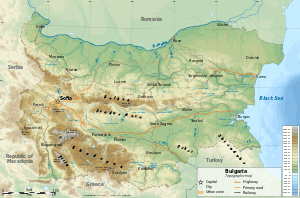
Bulgaria is a country in southeastern Europe situated entirely in the Balkan peninsula. The county is inhabited by 38 reptilian species, which makes the reptiles the second least diverse class of vertebrates in the country, after the amphibians.[1] The list includes four species that have not been recorded in the country since the first half of the 20th century – the loggerhead sea turtle, green sea turtle, aspic viper and meadow viper. There are four turtle and two tortoise species of four families – Cheloniidae, Emydidae, Geoemydidae and Testudinidae; 14 lizard species of four families – Anguidae, Gekkonidae, Lacertidae and Scincidae; and 18 snake species of four families – Boidae, Colubridae, Typhlopidae and Viperidae. In addition, in recent years one turtle species, the North American red-eared slider, has been registered in numerous bodies of water all over the country and is not included in the list.[2] The other two extant orders, Crocodilia and Rhynchocephalia, are not represented in Bulgaria.
The foundations of Bulgarian herpetology, or studies of amphibians and reptiles, were laid in the end of the 19th century by the teacher Vasil Kovachev, who published a number of articles on the subject and the 1912 book Herpetologic Fauna of Bulgaria.[3] In the 1930s and 1940s zoologist Ivan Buresh and his associate Yordan Tsonkov conducted in-depth research on the diversity and distribution of the amphibian and reptile species in the country. In the second half of the 20th century the leading Bulgarian herpetologist was Dr. Vladimir Beshkov.[3]
Bulgaria provides various habitats for reptiles. The country falls within six terrestrial ecoregions of the Palearctic ecozone: Balkan mixed forests, Rodope montane mixed forests, Euxine-Colchic deciduous forests, Aegean and Western Turkey sclerophyllous and mixed forests, East European forest steppe and Pontic–Caspian steppe.[4] Bulgaria has varied topography. From north to south the main geomorphological regions are the Danubian Plain, the Balkan Mountains, the Sub-Balkan valleys, the Rila–Rhodope massif to the south-west, the Upper Thracian Plain and the Strandzha mountains to the south-east. Most of the country is situated within the humid continental climate region, with Alpine climate in the highest mountains and Mediterranean climate in the southernmost regions.[5] The highest diversity of reptiles is recorded in southernmost Bulgaria – the valley of the river Struma, the eastern Rhodope Mountains, the southern reaches of the river Maritsa and Strandzha.
Status
Conservation status at a world level (not exclusive to Bulgaria) of the species according to the IUCN Red List, which includes:
- EX – Extinct, EW – Extinct in the wild
- CR – Critically endangered, EN – Endangered, VU – Vulnerable
- NT – Near threatened, LC – Least concern
- DD – Data deficient, NE – Not evaluated
Order Testudines
Family Cheloniidae
Cheloniidae are a family of sea turtles with worldwide distribution in all tropical oceans. The family contains seven species in five genera,[6] of which two species have been recorded in the waters off the Bulgarian Black Sea Coast.[7]
| Species | Common name | Distribution | Status | Image |
|---|---|---|---|---|
| Caretta caretta | loggerhead sea turtle | Recorded twice along the Bulgarian Black Sea Coast, off Shabla and Primorsko[8] | |
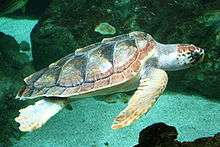 |
| Chelonia mydas | green sea turtle | Recorded only once along the Bulgarian Black Sea Coast, off Sozopol[10] | |
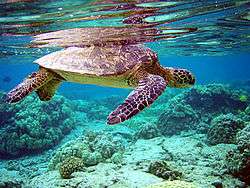 |
Family Emydidae
Emydidae, also known as pond or march turtles, are a family of fresh water turtles. With the exception of two species, they are only found in the Western Hemisphere. There are close to 50 species in 10 genera,[12] of which one species occurs in Bulgaria.[13]
| Species | Common name | Distribution | Status | Image |
|---|---|---|---|---|
| Emys orbicularis | European pond turtle | Found in the rivers and lakes all over the country; recorded up to 1100 m altitude on Lozen Mountain[14] | |
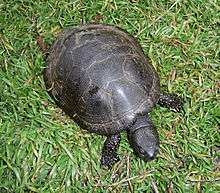 |
Family Geoemydidae
Geoemydidae are one of the largest and most diverse turtle families. They are distributed in North America, northern South America, Europe, northwestern Africa and Asia. The family contains about 70 species in 19 genera,[16] of which one species occurs in Bulgaria.[17]
| Species | Common name | Distribution | Status | Image |
|---|---|---|---|---|
| Mauremys rivulata | Balkan pond turtle | Found in the southernmost regions of the country: the lower course of the rivers Struma, Arda, Maritsa and Tundzha, as well as in the rivers south of the Ropotamo along the Black Sea coast[18] | |
|
Family Testudinidae
Testudinidae, also known as tortoises, are a family of land-dwelling turtles found in North and South America, Europe, Africa and Asia. They are terrestrial and inhabit warm areas ranging from rain forests to deserts. The family contains about 50 species in 11 genera,[20] of which 2 species are found in Bulgaria.[21]
| Species | Common name | Distribution | Status | Image |
|---|---|---|---|---|
| Testudo graeca | spur-thighed tortoise | Found in the lowlands of the country: the Danube and Upper Thracian Plains, the Black Sea coast and some river valleys[22] | |
|
| Testudo hermanni | Hermann's tortoise | Found in the lowlands of the country: the Danube and Upper Thracian Plains, the Black Sea coast and some river valleys; recorded up to 1450 m altitude in the mountains[24] | |
 |
Order Squamata
Suborder Lacertilia
Family Anguidae
Anguidae are a family of legless lizards distributed in the Northern Hemisphere. The group includes both egg-laying and viviparous species. There are 73 species in 10 genera,[26][27] of which three species occur in Bulgaria.[28]
| Species | Common name | Distribution | Status | Image |
|---|---|---|---|---|
| Anguis colchica | Eastern slow worm | Found in most regions of the country[29][30] | |
 |
| Anguis fragilis | slow worm | Rhodope mountains[29][30] | |
 |
| Pseudopus apodus | European legless lizard | Occurs in the lowlands of south-eastern Bulgaria and along the Black Sea coast, with isolated populations in the lower valleys of the rivers Rusenski Lom and Struma[33] | |
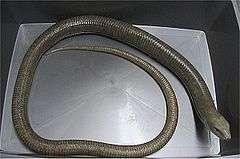 |
Family Gekkonidae
Gekkonidae are a large family of small to mid-size geckos. They have global distribution with particular diversity in tropical areas. Gekkonidae include 1033 species in 51 genera,[35] of which one species is found in Bulgaria.[36]
| Species | Common name | Distribution | Status | Image |
|---|---|---|---|---|
| Cyrtopodion kotschyi | Kotschy's gecko | Found in south-eastern Bulgaria, including the Upper Thracian Plain and the eastern Rhodope Mountains, as well as along the Black Sea coast and the lower Struma valley[14] | |
 |
Family Lacertidae
Lacertidae are a family of true lizards or wall lizards native to Europe, Asia and Africa. The European and Mediterranean species inhabit mainly forest and scrub habitats.[38] There are 321 species in 37 genera,[39] of which nine species occur in Bulgaria.[40]
| Species | Common name | Distribution | Status | Image |
|---|---|---|---|---|
| Darevskia praticola | meadow lizard | Found in most of the country, except for the south-western regions and the Upper Thracian valley[40] | |
 |
| Lacerta agilis | sand lizard | Found in Rila, Pirin, western Rhodope Mountains, western and central Balkan Mountains, Sredna Gora and Osogovo, as well as isolated populations in Strandzha and the northern Black Sea coast[42] | |
 |
| Lacerta trilineata | Balkan green lizard | Most common in the lowlands of eastern Bulgaria, as well as in the lower Struma valley[44] | |
 |
| Lacerta viridis | European green lizard | Common throughout the country, except for the highest mountains[46] | |
|
| Ophisops elegans | snake-eyed lizard | Inhabits only a small area in the eastern Rhodope Mountains and the lower valley of the Maritsa river[48] | |
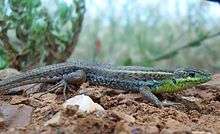 |
| Podarcis erhardii | Erhard's wall lizard | Occurs in south-western Bulgaria and the eastern Rhodope Mountains[50] | |
 |
| Podarcis muralis | common wall lizard | Widespread throughout the whole country[52] | |
 |
| Podarcis tauricus | Balkan wall lizard | Found in the lowlands of northern and eastern Bulgaria, as well as in the lower Struma valley[54] | |
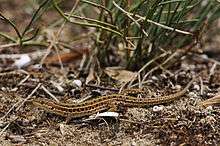 |
| Zootoca vivipara | viviparous lizard | Found in Rila, Pirin, Vitosha, the western Rhodope Mountains, the western and central Balkan Mountains and Osogovo[56] | |
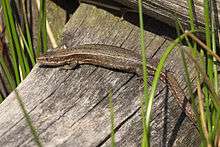 |
Family Scincidae
Scincidae are a cosmopolitan family occurring in a variety of habitats worldwide, apart from boreal and polar regions. With 1589 species, of which one is found in Bulgaria,[58] Scincidae are among the most diverse lizard families.[59]
| Species | Common name | Distribution | Status | Image |
|---|---|---|---|---|
| Ablepharus kitaibelii | European copper skink | Found throughout the whole country, except for some areas to the south-west[60] | |
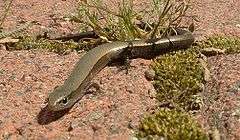 |
Suborder Serpentes
Family Boidae
Boidae are a family of nonvenomous snakes found in America, Africa, Europe, Asia, and some Pacific Islands. There are 58 species in 8 genera,[62] of which one species occurs in Bulgaria.[63]
| Species | Common name | Distribution | Status | Image |
|---|---|---|---|---|
| Eryx jaculus | javelin sand boa | Found in south-eastern Bulgaria, as well as in isolated populations in the lower Struma valley and around Svishtov along the Danube river bank[64] | |
 |
Family Colubridae
Colubridae are a family of snakes with worldwide distribution found on every continent except Antarctica. There are 844 species in 118 genera,[66][67] of which 12 species occur in Bulgaria.[68]
| Species | Common name | Distribution | Status | Image |
|---|---|---|---|---|
| Coronella austriaca | smooth snake | Found in the whole country, up to 1600 m altitude; rarely recorded up to 2200 m[69] | |
 |
| Dolichophis caspius | Caspian whipsnake | Inhabits most of the country, except for the high mountains of southwestern Bulgaria[71] | |
 |
| Elaphe quatuorlineata | four-lined snake | Found only in the southern Struma valley[73] | |
 |
| Elaphe sauromates | blotched snake | Occurs in the Upper Thracian Plain, the Danubian Plain, Dobrudzha and the Black Sea coast[75] | |
.jpg) |
| Malpolon monspessulanus | Montpellier snake | Found in southern Bulgaria: lower Struma valley, eastern Rhodope Mountains, Dervent Heights and Strandzha[77] | |
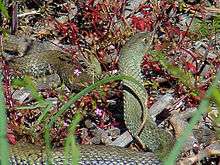 |
| Natrix natrix | grass snake | Found all over the country[79] | |
 |
| Natrix tessellata | dice snake | Occurs all over the country, up to 1100 m altitude[81] | |
 |
| Platyceps collaris | red whip snake | Found in several populations along the Black Sea coast to the south of Sozopol[83] | |
 |
| Platyceps najadum | Dahl's whip snake | Found in south-western Bulgaria, the eastern Rhodope Mountains, the northern foothills of the western Rhodope Mountains and the Dervent Heights[85] | |
|
| Telescopus fallax | European cat snake | Found in the southern Struma valley and the eastern Rhodope Mountains[87] | |
 |
| Zamenis longissimus | Aesculapian snake | Widespread throughout the whole country, up to 1600 m altitude, rarely recorded up to 2000 m in Belasitsa[89] | |
 |
| Zamenis situla | European ratsnake | Found in the southern Struma valley, the foothills of the western Rhodope Mountains and the southern Black Sea coast[91] | |
 |
Family Typhlopidae
Typhlopidae are a family of blind snakes found mostly in the tropical regions of Africa, Asia, the Americas, Australia and various islands. There are 381 species in 29 genera,[93] of which one species is native to Bulgaria and Europe.[94]
| Species | Common name | Distribution | Status | Image |
|---|---|---|---|---|
| Typhlops vermicularis | European blind snake | Found in southern Bulgaria: lower Struma valley, eastern Rhodope Mountains, Dervent Heights and Strandzha, and the southern Black Sea coast[94] | |
 |
Family Viperidae
Viperidae are a family of venomous snakes found worldwide, except in Antarctica, Australia, New Zealand, Ireland, Madagascar, Hawaii and various other isolated islands. They include 329 species in 33 genera,[93] of which four species occur in Bulgaria.[96]
| Species | Common name | Distribution | Status | Image |
|---|---|---|---|---|
| Vipera ammodytes | horned viper | Found in the whole country, up to 1450 m altitude[97] | |
|
| Vipera aspis | aspic viper | Only two specimens have been recorded in Bulgaria – one found near Harmanli in 1933, the other in unknown location in the beginning of the 20th century[99] | |
 |
| Vipera berus | common European adder | Occurs in the mountains, at an altitude of 1000–2700 m – Rila, Pirin, Vistosha, western Rhodope Mountains, western and central Balkan Mountains, central Sredna Gora and Osogovo.[101] | |
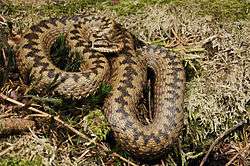 |
| Vipera ursinii | meadow viper | Known only from a few specimen found in the Shumen Plateau and Lyulin Mountain; there are no records since 1934[103] | |
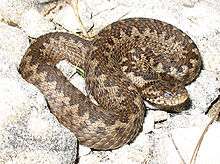 |
See also
- Geography of Bulgaria
- List of amphibians of Bulgaria
- List of birds of Bulgaria
- List of mammals of Bulgaria
- List of protected areas of Bulgaria
References
- ↑ Biserkov, 2007, p. 34
- ↑ Biserkov, 2007, p. 71
- 1 2 Biserkov, 2007, p. 28
- ↑ "Ecoregions of Bulgaria". The Encyclopedia of Earth. Retrieved 13 July 2015.
- ↑ Donchev, Karakashev, 2004, pp. 55, 59–61
- ↑ "Cheloniidae". Animal Diversity Web. Retrieved 25 March 2015.
- ↑ Biserkov, 2007, p. 74
- ↑ Biserkov, 2007, p. 75
- ↑ Arntzen, J.W.; et al. (2009). "Caretta caretta". IUCN Red List of Threatened Species. Version 2008. International Union for Conservation of Nature. Retrieved 18 March 2015.
- ↑ Biserkov, 2007, p. 76
- ↑ Arntzen, J.W.; et al. (2009). "Chelonia mydas". IUCN Red List of Threatened Species. Version 2008. International Union for Conservation of Nature. Retrieved 18 March 2015.
- ↑ Rhodin 2010, pp. 000.99-000.107
- ↑ Biserkov, 2007, p. 69
- 1 2 Biserkov, 2007, p. 70
- ↑ Arntzen, J.W.; et al. (2009). "Emys orbicularis". IUCN Red List of Threatened Species. Version 2008. International Union for Conservation of Nature. Retrieved 18 March 2015.
- ↑ Rhodin 2010, p. 000.91
- ↑ Biserkov, 2007, p. 72
- ↑ Biserkov, 2007, p. 73
- ↑ "Mauremys rivulata". The Reptile Database. Retrieved 18 March 2015.
- ↑ "Testudinidae". Animal Diversity Web. Retrieved 25 March 2015.
- ↑ Biserkov, 2007, p. 66
- ↑ Biserkov, 2007, p. 68
- ↑ Arntzen, J.W.; et al. (2009). "Testudo graeca". IUCN Red List of Threatened Species. Version 2008. International Union for Conservation of Nature. Retrieved 18 March 2015.
- ↑ Biserkov, 2007, p. 67
- ↑ Arntzen, J.W.; et al. (2009). "Testudo hermanni". IUCN Red List of Threatened Species. Version 2008. International Union for Conservation of Nature. Retrieved 18 March 2015.
- ↑ "Anguidae". Animal Diversity Web. Retrieved 25 March 2015.
- ↑ "Anguidae". The Reptile Database. Retrieved 25 March 2015.
- ↑ Biserkov, 2007, p. 88
- 1 2 Biserkov, 2007, p. 89
- 1 2 Gvozdík, Václav; Jandzik, David; Lymberakis, Petros; Jablonski, Daniel; Moravec, Jirí (2010). "Slow worm, Anguis fragilis (Reptilia: Anguidae) as a species complex: Genetic structure reveals deep divergences" (PDF). Molecular Phylogenetics and Evolution. Elsevier. 55: 464, 470. doi:10.1016/j.ympev.2010.01.007. Retrieved 3 October 2015.
- ↑ "Anguis colchica". The Reptile Database. Retrieved 3 October 2015.
- ↑ "Anguis fragilis". The Reptile Database. Retrieved 18 March 2015.
- ↑ Biserkov, 2007, p. 90
- ↑ "Pseudopus apodus". The Reptile Database. Retrieved 18 March 2015.
- ↑ "Gekkonidae". The Reptile Database. Retrieved 25 March 2015.
- ↑ Biserkov, 2007, p. 83
- ↑ Arntzen, J.W.; et al. (2009). "Cyrtopodion kotschyi". IUCN Red List of Threatened Species. Version 2008. International Union for Conservation of Nature. Retrieved 18 March 2015.
- ↑ Bauer, Aaron M. (1998). Cogger, H.G.; Zweifel, R.G., eds. Encyclopedia of Reptiles and Amphibians. San Diego: Academic Press. pp. 163–165. ISBN 0-12-178560-2.
- ↑ "Lacertidae". The Reptile Database. Retrieved 18 June 2015.
- 1 2 Biserkov, 2007, p. 91
- ↑ Arntzen, J.W.; et al. (2009). "Darevskia praticola". IUCN Red List of Threatened Species. Version 2008. International Union for Conservation of Nature. Retrieved 18 March 2015.
- ↑ Biserkov, 2007, p. 93
- ↑ Arntzen, J.W.; et al. (2009). "Lacerta agilis". IUCN Red List of Threatened Species. Version 2008. International Union for Conservation of Nature. Retrieved 18 March 2015.
- ↑ Biserkov, 2007, p. 95
- ↑ Arntzen, J.W.; et al. (2009). "Lacerta trilineata". IUCN Red List of Threatened Species. Version 2008. International Union for Conservation of Nature. Retrieved 18 March 2015.
- ↑ Biserkov, 2007, p. 96
- ↑ Arntzen, J.W.; et al. (2009). "Lacerta viridis". IUCN Red List of Threatened Species. Version 2008. International Union for Conservation of Nature. Retrieved 18 March 2015.
- ↑ Biserkov, 2007, p. 97
- ↑ "Ophisops elegans". The Reptile Database. Retrieved 18 March 2015.
- ↑ Biserkov, 2007, p. 99
- ↑ Arntzen, J.W.; et al. (2009). "Podarcis erhardii". IUCN Red List of Threatened Species. Version 2008. International Union for Conservation of Nature. Retrieved 18 March 2015.
- ↑ Biserkov, 2007, p. 101
- ↑ Arntzen, J.W.; et al. (2009). "Podarcis muralis". IUCN Red List of Threatened Species. Version 2008. International Union for Conservation of Nature. Retrieved 18 March 2015.
- ↑ Biserkov, 2007, p. 102
- ↑ Arntzen, J.W.; et al. (2009). "Podarcis tauricus". IUCN Red List of Threatened Species. Version 2008. International Union for Conservation of Nature. Retrieved 18 March 2015.
- ↑ Biserkov, 2007, p. 103
- ↑ Arntzen, J.W.; et al. (2009). "Zootoca vivipara". IUCN Red List of Threatened Species. Version 2008. International Union for Conservation of Nature. Retrieved 18 March 2015.
- ↑ Biserkov, 2007, p. 86
- ↑ "Scincidae". The Reptile Database. Retrieved 18 June 2015.
- ↑ Biserkov, 2007, p. 87
- ↑ Arntzen, J.W.; et al. (2009). "Ablepharus kitaibelii". IUCN Red List of Threatened Species. Version 2008. International Union for Conservation of Nature. Retrieved 18 March 2015.
- ↑ "Boidae". The Reptile Database. Retrieved 18 June 2015.
- ↑ Biserkov, 2007, p. 110
- ↑ Biserkov, 2007, p. 111
- ↑ "Eryx jaculus". The Reptile Database. Retrieved 18 March 2015.
- ↑ Bauer, Aaron M. (1998). Cogger, H.G.; Zweifel, R.G., eds. Encyclopedia of Reptiles and Amphibians. San Diego: Academic Press. pp. 188–195. ISBN 0-12-178560-2.
- ↑ "Colubridae". The Reptile Database. Retrieved 18 June 2015.
- ↑ Biserkov, 2007, p. 112
- ↑ Biserkov, 2007, p. 124
- ↑ "Coronella austriaca". The Reptile Database. Retrieved 18 March 2015.
- ↑ Biserkov, 2007, p. 115
- ↑ "Dolichophis caspius". The Reptile Database. Retrieved 18 March 2015.
- ↑ Biserkov, 2007, p. 121
- ↑ "Elaphe quatuorlineata". The Reptile Database. Retrieved 18 March 2015.
- ↑ Biserkov, 2007, p. 122
- ↑ "Elaphe sauromates". The Reptile Database. Retrieved 18 March 2015.
- ↑ Biserkov, 2007, p. 127
- ↑ Arntzen, J.W.; et al. (2009). "Malpolon monspessulanus". IUCN Red List of Threatened Species. Version 2008. International Union for Conservation of Nature. Retrieved 18 March 2015.
- ↑ Biserkov, 2007, p. 125
- ↑ Arntzen, J.W.; et al. (2009). "Natrix natrix". IUCN Red List of Threatened Species. Version 2008. International Union for Conservation of Nature. Retrieved 18 March 2015.
- ↑ Biserkov, 2007, p. 126
- ↑ Arntzen, J.W.; et al. (2009). "Natrix tessellata". IUCN Red List of Threatened Species. Version 2008. International Union for Conservation of Nature. Retrieved 18 March 2015.
- ↑ Biserkov, 2007, p. 117
- ↑ Arntzen, J.W.; et al. (2009). "Platyceps collaris". IUCN Red List of Threatened Species. Version 2008. International Union for Conservation of Nature. Retrieved 18 March 2015.
- ↑ Biserkov, 2007, p. 116
- ↑ Arntzen, J.W.; et al. (2009). "Platyceps najadum". IUCN Red List of Threatened Species. Version 2008. International Union for Conservation of Nature. Retrieved 18 March 2015.
- ↑ Biserkov, 2007, p. 128
- ↑ Arntzen, J.W.; et al. (2009). "Telescopus fallax". IUCN Red List of Threatened Species. Version 2008. International Union for Conservation of Nature. Retrieved 18 March 2015.
- ↑ Biserkov, 2007, p. 119
- ↑ Arntzen, J.W.; et al. (2009). "Zamenis longissimus". IUCN Red List of Threatened Species. Version 2008. International Union for Conservation of Nature. Retrieved 18 March 2015.
- ↑ Biserkov, 2007, p. 120
- ↑ Arntzen, J.W.; et al. (2009). "Zamenis situla". IUCN Red List of Threatened Species. Version 2008. International Union for Conservation of Nature. Retrieved 18 March 2015.
- 1 2 "Typhlopidae". The Reptile Database. Retrieved 18 June 2015.
- 1 2 Biserkov, 2007, p. 109
- ↑ "Typhlops vermicularis". The Reptile Database. Retrieved 18 March 2015.
- ↑ Biserkov, 2007, p. 130
- ↑ Biserkov, 2007, p. 131
- ↑ Arntzen, J.W.; et al. (2009). "Vipera ammodytes". IUCN Red List of Threatened Species. Version 2008. International Union for Conservation of Nature. Retrieved 18 March 2015.
- ↑ Biserkov, 2007, p. 135
- ↑ Arntzen, J.W.; et al. (2009). "Vipera aspis". IUCN Red List of Threatened Species. Version 2008. International Union for Conservation of Nature. Retrieved 18 March 2015.
- ↑ Biserkov, 2007, p. 133
- ↑ Arntzen, J.W.; et al. (2009). "Vipera berus". IUCN Red List of Threatened Species. Version 2008. International Union for Conservation of Nature. Retrieved 18 March 2015.
- ↑ Biserkov, 2007, p. 134
- ↑ Arntzen, J.W.; et al. (2009). "Vipera ursinii". IUCN Red List of Threatened Species. Version 2008. International Union for Conservation of Nature. Retrieved 18 March 2015.
Sources
- Бисерков, В. (V. Biserkov) (2007). Определител на земноводните и влечугите в България [A Field Guide to Amphibians and Reptiles of Bulgaria] (in Bulgarian). София (Sofia): Зелени Балкани (Green Balkans). ISBN 978-954-9433-07-4.
- Бешков (Beshkov), Владимир (Vladimir); Нанев (Nanev), Кръстьо (Krastyo) (2002). Земноводни и влечуги в България (Amphibians and Reptiles of Bulgaria) (in Bulgarian). София (Sofia): Пенсофт (Pensoft). ISBN 954-642-147-2.
- Дончев (Donchev), Дончо (Doncho); Каракашев (Karakashev), Христо (Hristo) (2004). Теми по физическа и социално-икономическа география на България (Topics on Physical and Social-Economic Geography of Bulgaria) (in Bulgarian). София (Sofia): Ciela. ISBN 954-649-717-7.
External links
- Naumov, B.; M.Stanchev. "Amphibians and reptiles of Bulgaria and the Balkan Peninsula" (in Bulgarian). An online edition of the Bulgarian Herpetological Society. Retrieved 18 March 2015.
- Mazzei, P. "Amphibians and reptiles of Europe". Retrieved 18 March 2015.
- "The Reptile Database". Retrieved 18 March 2015.
- "The IUNC List of Threatened Species". Retrieved 18 March 2015.
- "Animal Diversity Web". University of Michigan. Retrieved 25 March 2015.
- Rhodin, Anders G.J.; Paul van Dijk, Peter; Inverson, John B.; Shaffer, H. Bradley. "Turtles of the world, 2010 update: Annotated checklist of taxonomy, synonymy, distribution and conservation status". pp. 000.89–000.138. Archived from the original (PDF) on 2010-12-15.
